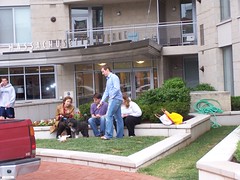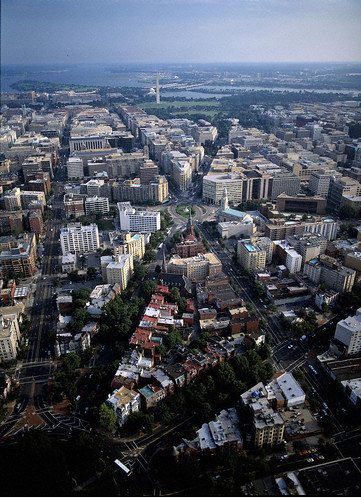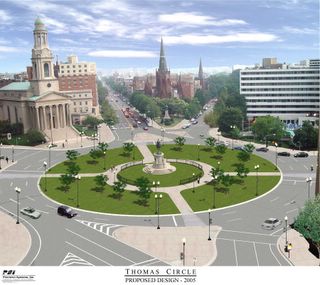What has DC done right? (updated)
In a comment, Cableflame asks a very good question:
... reading your blog for a while, I've noticed that you're always pointing out things that other cities have gotten right. However, it makes me think... what has DC gotten right? ... I'd love to see you do an issue on the things that DC has that we've gotten right that other cities don't have.
I can't claim this is comprehensive or in order or exclusive to DC necessarily. In other words, other cities have done many similar things, but these are the things that I believe show off our city to great advantage.
------
4 more things added at the end, 1.5 of which I meant to write about at first, but forgot + 3 honorable mentions.
------
Here goes:
In the last 20-30 years? WMATA. The relatively closely spaced metro stations in the core of the city have provided the foundation for revitalization and repopulation of the center city, with great intra-city mobility at the center. (The problem is mobility in places where the subway doesn't go, which is supposed to be addressed by Bringing Back Streetcars, see below.)
In the last 10 years, putting teeth into the requirement of adding housing to create a living downtown. Having people living downtown creates a constituency to support revitalization and the provision of amenities that appeal to people besides office denizens.
You see the benefits of adding housing (and density) in what had been more commercial areas in other ways. More people on the street at more times of the day and night. In early September I walked one night from Reeves Center to McPherson Square. There were goodly numbers of people on every block!

You see people walking dogs on the 400, 500, and 600 blocks of Massachusetts Avenue NW. The Synagogue at 6th and I was renovated and people who aren't homeless even use the park across the street. Etc.
In the last 7 years. BID legislation. I favor BIDs although I think they should use the "Main Street model," focus more attention on the development of independent business, and add citizen members to the boards appointed outside of the BID-controlled nominating process because fundamentally these organizations are privatizing public spaces. (Pretty much, BIDs are controlled by property owners and they will only invest in the public realm and amenities to the extant the marginal return is revenue positive.) But in any case they are keeping the public spaces clean and they are contributing to marked improvements in public safety in those areas.
In the last 30 years or so? Historic preservation laws and the neighborhood preservation movement, which stabilized neighborhoods in the face of continued disinvestment in cities generally, and this city specifically. DC wouldn't be a place worth living in today if it hadn't been for the historic preservation movement. (DC's preservation laws are some of the strongest in the country although they were gamed more in the Barry mayoralty.)
The flipside of the strong neighborhood preservation movement has been an overfocusing of the preservation movement, away from Downtown and citywide issues. As a result, in the 1980s mostly, most of the historic buildings in downtown Washington were demolished in favor of boxy superbuildings on what became the equivalent of superblocks. People-based rhythms at the street level were destroyed. And memory has been erased.
In the last 5 years or so? The kind of mixed-use development happening in the 14th and U Street corridors. Many of the developers in that area seem to understand the fundamental importance of (and greater economic returns from) urbanity. Specific companies are Donatelli & Klein (the Ellington building) and Abdo Development. I hear good things about Jair Lynch too. We'll see. Of course, landing Whole Foods helped, so Carol Felix and the other people who organized this successful campaign deserve a big chunk of credit too.
Key priming action: 9:30 Club moving over to WUST Music Hall in the early 1990s. Frankly that communicated to many long before much else happened, that the area was going to improve. The then owner of the 9:30 Club, Cellar Door Productions, was well-respected, a nationally recognized player in the industry, and this communicated to investors that the U Street area would be a good place to start investing in. (And no, Reeves Center didn't do much of anything to improve this area. And it still doesn't.)
Some of the retail in that area is particularly good, some of the only places in the city with newly developing interesting independent retail, including Muleh, Garden District, Urban Essentials, Busboys & Poets (more a restaurant cafe than a bookstore but still cool as hell), Pulp, and some of those restaurants. Cake Love is a publicity phenomenon, but the product could be better.
And lest we forget, the Studio Theater staked out the area first, in the 1970s. More arts and culture uses came. And music--The Black Cat, and of course, I still miss the Metro Cafe (it's the last place I saw "Dead Girls and Other Stories"--whatever happened to that band?--I lost my CD!).
In the last 5 years, the infill NY Avenue Metro Station, which is pushing forward a needed transformation of the area north of Union Station. Already this station has had major impact on neighborhoods and a minimum increase in property value of $450 million just for the neighborhood immediately east. OTOH, it does put tremendous pressure on the Florida Market, as I have written about.
In the last 5 years, creation of an independent DC Department of Transportation with a greater focus on transportation, mobility, and the public realm and streetscape beyond the automobile. The developing success of Barracks Row (8th Street SE) is a perfect example of this. The initiative to bring back streetcars also derives from this change (or at least broadening) of mission. And Thomas Circle!
Thomas Circle (in the middle) before

Advertising and commercial use are prohibited. Photo by Jason Hawkes for the Washington, DC Convention & Tourism Corporation (WCTC).
Thomas Circle after (rendering, but it looks pretty close, the dedication ceremony was a couple months ago...)

I don't know exactly when, but not converting Eastern Market into a food court. It took awhile, and the fortuitous addition of a crafts market on the weekends further pushed forward transformation, but today the vibrance of the Eastern Market area of Capitol Hill makes the neighborhood a weekend destination for residents and visitors. The businesses on 7th Street are open on weekends now, and a Marvelous Market just opened, while at the other end of the street Port City Java opened in the summer. Now if you could get rid of the Washington Mutual mortgage office across the street (how was that use variance ever approved?) and replace it with Trader Joes, get Bread and Chocolate to stay open in the evening, fix the Eastern Market Metro Plaza, and figure out what to do with Hine Junior High School, the area will get even better.
In the last 10 years, the revitalization of 7th Street NW, the "East End." Many people attribute this to Abe Pollin and the creation of what was originally called the MCI Center, but it's much more complicated than that. The Shakespeare Theater, Jaleo, the galleries on the southern end started the renaissance in the early 1990s long before anybody ever thought that the Washington Bullets could ever come back to the city. But there is no question that the arena brings more people to the area, increased the willingness of suburbanites to sample the city, and changed the risk climate for investors and developers.
The restoration of many historic buildings by Doug Jemal in particular the west side of the 700 block contributes greatly, even as new denser buildings were constructed in the area. This is the longest stretch of downtown that maintains the historic rhythm of the street (with storefronts every 40 feet or so) for pedestrians, and it's exciting to see the vibrance and activity there, even if I am not about to go to Hooters. Now the Smithsonian Museums have reopened there, the Goethe Institut is there, and for fast food, Five Guys isn't so bad either... Of course, Chinatown has become Gallery Place, and if you're searching for an Asian neighborhood you need to go to Fairfax County. (Turn down the volume on the Verizon Center video screen!)
Remember the foundation of great urban experiences--in a "real" city--is based on walking!
And in the last month, the reopening of the Atlas Theater (which took 5 years). Jane Lang shows what can be done with a helluva lot of effort, gumption, the support of family and friends, and hard work. The Robeys of the H Street Playhouse deserve a good bit of credit for helping to get the Atlas Theater out of the clutches of a community development corporation which had mothballed the building with intentions to demolish, by their leading the "Atlas Theater Project." They ended up not getting the Atlas, but opened their own theater--a few years earlier--just down the street. (Arts uses like this are common augurs of revitalization across the county. But pulling together the financing and making it happen are hard. For every project. And every successful project deserves to be celebrated.) Honorable mention: Avalon Theater Project, and why can't we get Mr. McGinty to not be wacked out and allow the same with the Takoma Theater?
Plus, $%^&*, how did the AFI Theater end up in Silver Spring? I know, Doug Duncan offered them a lot of money to leave Kennedy Center! But imagine if this had happened in the Tivoli Theater or the Howard Theater instead. This would have speeded up revitalization of those areas by 5 years at least. (Of course, back then, DC was broke. It's hard to remember that in the face of today's success and demand for urban living.)
Sometime in the 1980s, the renovation of the Sumner School, on a long term lease with a developer. Rather than sell the property, Richard Hurlbutt of DCPS conceived of a long term lease arrangement where the developer could build an office building on the playground and use the Magruder School, while DCPS would convert Sumner School into a meeting center and archives, with the cost of rehabilitation and ongoing maintenance paid for and conducted by the developer. It's probably why it's the only DC Government facility that is adequately maintained, other than City Hall and the main DC Government buildings--the contractors know who butters their bread there. Lamentably, this pathbreaking example hasn't been used very often to shape other asset dispositions by the city.
In the last maybe 8 years, the Wayfinding signage program pushed forward by Joe Sternlieb and Anne Marie Bairstow, the Downtown BID and others. It took them three years to get the US DOT and other agencies to sign off. But the initial set of signs for downtown has been expanded to include most city neighborhoods, expanded into maps for bus shelters (something that WMATA has since taken up), and the history trails signs (see next entry). Yes, other cities have such programs, but those cities didn't have to convince the federal government to sign off on the creation of the program in the same way as DC.
In the last 8 years, the creation of what is now called CulturalTourismDC by Kathy Smith, to focus on the promotion of local cultural heritage, not just for visitors to the city, but for residents as well. Their activities include the twice yearly Walking Town set of tours around the city, as well as the very successful and important set of history trails (also funded in part by the DC Department of Transportation), guidebooks, and other information, the Call Box art program and other projects. Kathy Smith's book Capital Assets is very important, as was their initial project in the Shaw neighborhoood.
And happening now, the about to be launched bus shelter improvement program. DDOT contracted with Adshel to make this happen. It hasn't happened yet, but they are working on it, hard and it will start happening next year. We will get decent bus shelters (although I personally preferred a different design) that will communicate that transit is valued and important. Shelters will provide places to provide information specific to the neighborhood, commercial district, and possibly public art opportunities. Plus, they will be launching a bikesharing program comparable to carsharing. And the city is using the money paid for this (Adshel will sell ads for the shelters in commercial districts) to fund the Great Streets program (which I hope won't fail, but that's another story...).
In 1988, the reopening of Union Station. What a jewel! A lot of people, not just Daniel Moynihan, worked very hard to make this happen, and people work hard to help keep the station a great place today. Sure it can improve--the public realm outside needs a great deal of love applied. And how the hell did the Commission on Fine Arts approve the ugly parking structure on the back? The old part looks like a prison, the new part like public housing--both are bad! But at least the front of the building (ignore the cars and the jersey barriers) and the interior are fabulous. And at the time, this was one of the largest renovations of a historic train station in the U.S. (Relatedly, in 1991, the opening of an adaptively reused Post Office next door, with the addition of Capitol City Brewing Co. and the National Postal Museum, as well as offices in the rest of the building.)
Honorable mention #1: in the late 1980s, the opening of 800 N. Capitol Street NW, a post- modernist building that took its cues from the GPO Building. It bears some resemblance to the Harold Washington Library in Chicago. It shows decent design is possible outside of the boxy glassed in crap on K Street and Station Place.
Honorable mention #2: changing the laws to allow brewpubs, even if really only Capitol City Brewing Company seems to be making it. (And yes, many other cities have brewpubs, but Cap City has some good products...) Plus speaking of restaurants as destinations, Jaleo, Kramerbooks, Ethiopian restaurants in Adams-Morgan in the 1980s...
Honorable mention #3: Georgetown, Dupont Circle, and Adams-Morgan--vibrant places that made the city attractive during the decades when most center cities, including DC, were for the most part, declining and believed to have no comeback potential within.
Please add your own suggestions and thoughts in the comments...
Index Keywords: urban-design-placemaking; urban-revitalization



0 Comments:
Post a Comment
<< Home